

10 Common interview questions for a UX designer role
source link: https://uxplanet.org/10-common-interview-questions-for-a-ux-designer-role-6cc130a9cd86
Go to the source link to view the article. You can view the picture content, updated content and better typesetting reading experience. If the link is broken, please click the button below to view the snapshot at that time.
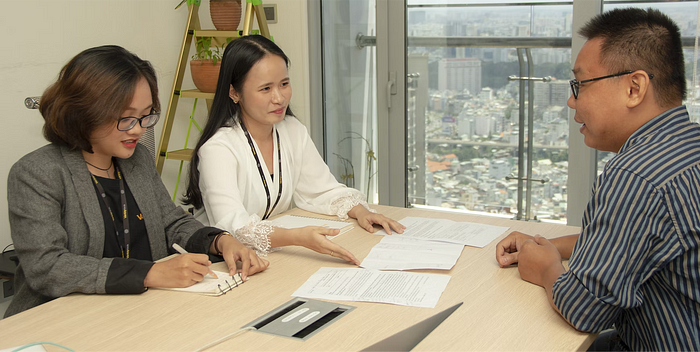
10 Common interview questions for a UX designer role
Landing a UX designer job requires a lot of hard work. Not only do you need a lot of preparation to get invited to the interview, but you also need to convince hiring managers that you’re the best candidate for this position. While it’s impossible to know beforehand what questions the interviewer will ask you, a few common questions come up frequently during UX designer interviews. This article will share ten popular questions and recommendations on how to answer them.
This article is also available in a video format:
Understand the mindset of the interviewer
Here is the list of questions that we will discuss in this article:
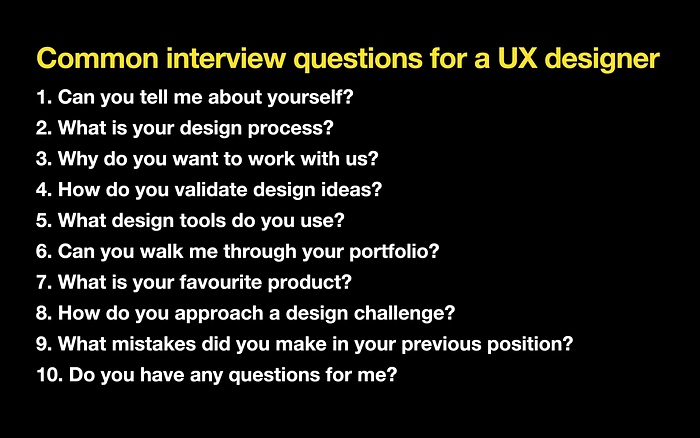
10 UX designer interview questions.
Before we dive into individual questions, it’s important to say a few words about the interviewing process many organizations follow. The interviewing process for a UX designer role typically has a few rounds. And the first round usually is very general; it’s the interview with a talent acquisition specialist who wants to know you a little bit better before sending your CV to the hiring manager who works in the design department. Usually, this interview is conducted in a format of a five-minute screener call. During the next round, you will be interviewed by someone who would be either your direct manager or your team member.
It’s important to get into the mindset of the person who runs the interview. Most of the time, hiring managers want to know whether you are capable of doing work and what it will feel like to work with you in the same collective. So when you answer the questions, remember to tell how you work and try to build a bond with the other person.
1. Can you tell me about yourself?
Why they ask this question: When hiring managers ask this question, they want to know what you can do for the company.
Don’t talk a lot about personal things. While it’s okay to mention what you like to do in your free time, hiring managers are more interested in learning more about your professional qualifications. So your answer should be based on what you do as a UX designer.
Talk about your interests in product design. Tell them what motivates you to do what you do.
Mention disciplines that you master in UX design. Many disciplines sit under the umbrella of UX design, and obviously, you cannot be an expert in all of them. When talking about yourself, try to describe your area of expertise.
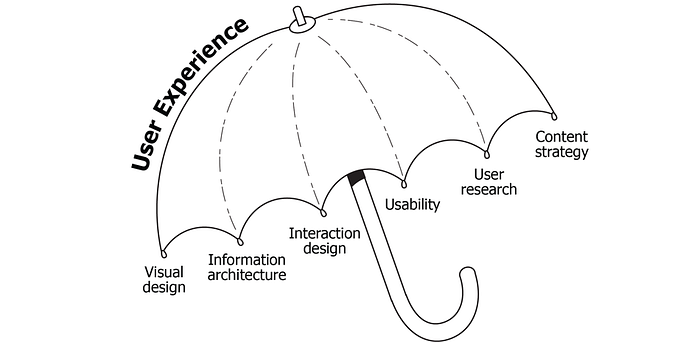
User experience umbrella. Image by Dan Willis.
2. What is your design process?
Why they ask this question: Hiring managers want to know how you approach design.
Don’t provide general answers. It’s true that the design process often consists of steps like researching, framing product requirements, prototyping, and validating your design with real users. Don’t just name those steps, be more specific and try to answer this question using one of the projects you worked on previously. You should share a fair amount of details that can help hiring managers understand how you work.
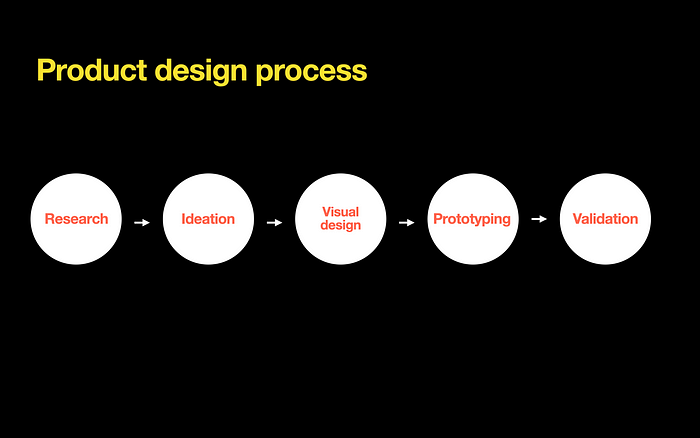
Conventional product design process.
Don’t try to adjust your process to make it sound conventional. It’s totally fine to follow your own process as long as you can explain the rationale behind your approach.
Tell a story about one of your products. You can use this question as an opportunity to tell a story that will create a context for your own design perspective and focus on the importance of human-centered experiences.
3. Why do you want to work with us?
Why they ask this question: Hiring managers want to learn about your motivation to join the team. They want to avoid facing a situation where after a few months of working in a new place, you realize that their company is not the one you want to work at, and you leave.
Don’t mention money or status. The worst way to answer this question is to say something like, “it’s good for my CV.” It will tell the hiring manager that you want to use them as a step for your career.
Don’t focus too much on your personal interests. You should also avoid saying things like “It will help me to grow skills” because it will sound like what you want to take from the company.
Talk about the value you can provide to the organization. The best way to answer this question is to talk about the value you can offer to this organization rather than what you can take from it. But to answer this question, you need to be familiar with the challenges that organizations face and match your previous experience and skills to the problems.
Be prepared and research a company and learn a job description. Don’t go to the interview without learning about what the company does and what product you’ll be working on. Try to read articles and watch YouTube videos about this company to understand their design philosophy and how it aligns with the company’s overall mission and goals. Check the job description carefully and try to match it to your own experience so you will be able to convince hiring managers how to address specific problems that the company faces.
4. How do you validate design ideas?
Why they ask this question: This question will help the hiring managers to learn whether you have practical experience running user research and usability testing sessions. And if you have, how exactly do you do it?
Don’t say that you don’t do it. Large companies have a separate role called UX researcher, who is responsible for user research. But despite that, if you apply to a UX designer position, you are likely expected to have practical experience doing research and analyzing results. If you answer you don’t validate your design ideas, it will be a red flag for them and a clear signal that you don’t practice user-centered design.
Try to describe your validation process. When answering this question, you need to tell how you define the research scope and run validation sessions to collect and analyze user feedback. And what is more important is what you do with the collected feedback. Again, you need to tell all this information using real examples from your past experience.
5. What design tools do you use?
Why they ask this question: The hiring manager might want to know if you have hands-on experience using a particular tool. Most likely the tool that organization uses.
Don’t pretend you have experience using a tool if you don’t have it. If you don’t have practical experience, be honest and tell the truth but mention that you will learn it.
If you have experience using the tool, you should always try to show examples of your work created using it.
6. Can you walk me through your portfolio?
Why they ask this question: Hiring managers want to evaluate your hard skills and communication skills
Don’t focus too much on visuals. Many designers make a critical mistake when answering this question. They focus too much on showing nice visuals. Instead, it’s better to focus on explaining the process you follow when designing products. The process is critical because it gives context to the projects you show.
Don’t dive into a lot of unnecessary details. When answering this question, you shouldn’t describe every little detail of every project you work on. Instead, you need to choose one or two projects that you are proud of. Ideally, you should use this question as an opportunity to demonstrate how you solve problems similar to the problems the organization faces. Ideally, you should structure your answer in a format of the story and tell hiring managers how you overcame problems. This question will also help the hiring manager understand how well you can communicate your ideas to other people.
Talk about a specific project you worked on and its impact on the user experience and business metrics. When describing your product, describe the following four parts:
- Goal of the project,
- Your role in the project,
- Your daily tasks and responsibilities,
- The result of the project.
Prepare the projects before going to the interview. Preparation is the key to answering this question correctly. Choose the project that you want to talk about before the interview. Try to communicate all this information in 5 or 10 minutes.
7. What is your favorite product?
Why they ask this question: How good you can articulate your point of view
This is a relatively simple question, but it can say a lot about you as a UX designer. You should always be ready to articulate your point of view.
Don’t just give a name without any details. You cannot say something like, “I like Apple Music because it allows me to play music.” You need to break down the product into individual design decisions and evaluate them in the context of the user experience.
Explain your rationale. The right way to answer this question is to name some features that this product offers and explain why you think such features are designed well. For example, in the context of Apple Music, you might say that this app offers an omnichannel experience, and it allows you to play music on any type of Apple device that you have.
8. How do you approach a design challenge?
Why do they ask this question: How well you can handle challenges.
Don’t say you didn’t face any challenges. The only way to avoid experiencing challenges is not to do anything.
Don’t make up challenges because you will likely be unable to answer follow-up questions if you start to make up things. Honesty is the best policy.
Be prepared to discuss specific design challenges and how you overcame them. Pick one or two good examples from your past experience that can tell other people how you are able to handle challenges. Try to think about a very specific example of a challenge that you overcome.
9. What mistakes did you make in your previous position?
Why do they ask this question: This question is intended to learn whether you are open to critique and honest with other people.
Don’t try to pretend that you are perfect.
Share the story about how you made a mistake but also how you were able to overcome it. Tell them:
- What went wrong,
- Why it went wrong,
- What you did to address the failure,
- What you learned from that experience.
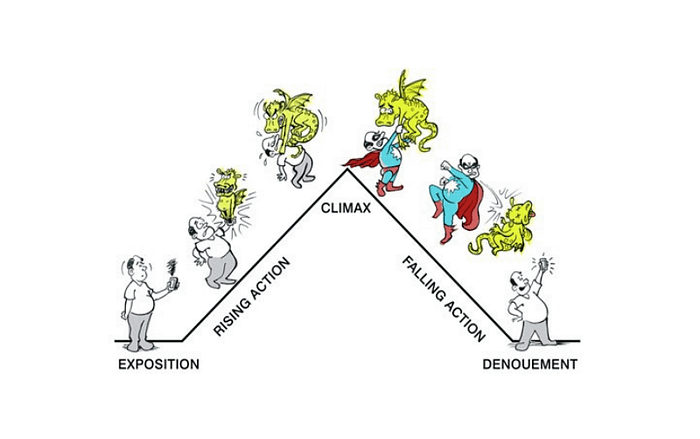
Use the Freytag pyramid when telling a story. This pyramid consists of five parts: exposition, rising action, climax, falling action, and denouement. Image by Ben Crothers.
10. Do you have any questions for me?
Why do they ask this question: They give you an opportunity to learn about the company
Don’t skip this part. When you answer “no,” you are missing a huge opportunity. You can learn more about design teams.
Prepare a list of 3–5 critical questions to help you understand the role and business. such as “How many people are on the design team?”, “How do people collaborate?” and “What is the roadmap for the product?”
Recommend
About Joyk
Aggregate valuable and interesting links.
Joyk means Joy of geeK